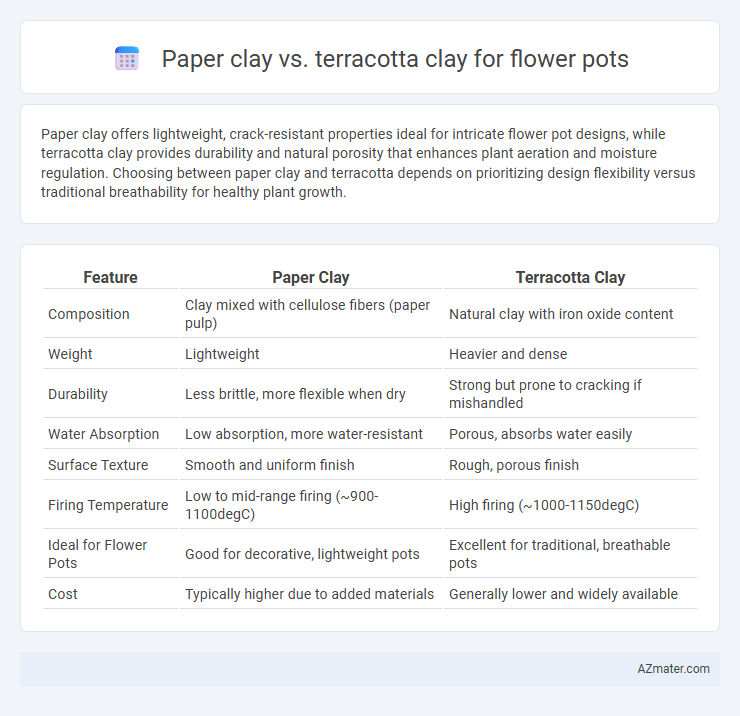Paper clay offers lightweight, crack-resistant properties ideal for intricate flower pot designs, while terracotta clay provides durability and natural porosity that enhances plant aeration and moisture regulation. Choosing between paper clay and terracotta depends on prioritizing design flexibility versus traditional breathability for healthy plant growth.
Table of Comparison
| Feature | Paper Clay | Terracotta Clay |
|---|---|---|
| Composition | Clay mixed with cellulose fibers (paper pulp) | Natural clay with iron oxide content |
| Weight | Lightweight | Heavier and dense |
| Durability | Less brittle, more flexible when dry | Strong but prone to cracking if mishandled |
| Water Absorption | Low absorption, more water-resistant | Porous, absorbs water easily |
| Surface Texture | Smooth and uniform finish | Rough, porous finish |
| Firing Temperature | Low to mid-range firing (~900-1100degC) | High firing (~1000-1150degC) |
| Ideal for Flower Pots | Good for decorative, lightweight pots | Excellent for traditional, breathable pots |
| Cost | Typically higher due to added materials | Generally lower and widely available |
Introduction to Paper Clay and Terracotta Clay
Paper clay, a lightweight and porous material made by mixing clay with paper fibers, offers enhanced strength and reduced drying times compared to traditional clays. Terracotta clay, a natural, iron-rich earthenware clay, is recognized for its porous, reddish-brown finish and excellent breathability, making it ideal for plant pots. Both materials serve distinct purposes in flower pot creation, with paper clay favoring delicate designs and faster drying, while terracotta excels in durability and natural water regulation.
Composition and Material Differences
Paper clay contains cellulose fibers mixed with natural clay, making it lighter and more flexible than traditional terracotta clay. Terracotta clay is primarily composed of natural earthen clay with iron oxide, which gives it a reddish-brown color and a porous, durable texture after firing. The fiber content in paper clay improves crack resistance and drying speed, whereas terracotta clay offers robust structural integrity ideal for outdoor flower pots.
Strength and Durability Comparison
Paper clay offers enhanced strength and durability for flower pots due to its lightweight composition blended with paper fibers, which reduces cracking during drying and firing. Terracotta clay, known for its traditional porous structure, provides moderate strength but is more susceptible to chipping and breakage under impact and fluctuating weather conditions. The fiber reinforcement in paper clay results in superior crack resistance and longer-lasting pots compared to the more brittle terracotta, making paper clay a preferred choice for durable and resilient flower containers.
Water Absorption and Drainage Properties
Paper clay exhibits lower water absorption and faster drying times compared to terracotta clay, making it less prone to water retention issues in flower pots. Terracotta clay has higher porosity, allowing better water absorption and natural drainage, which benefits plant roots by preventing waterlogging. The porous structure of terracotta ensures excess moisture evaporates efficiently, while paper clay's denser composition requires careful watering management to avoid root rot.
Weight and Handling Ease
Paper clay is significantly lighter than terracotta clay due to its cellulose fiber content, making it easier to handle and shape, especially for beginners or delicate designs. Terracotta clay is denser and heavier, providing sturdiness but requiring more effort during molding and drying stages. The lightweight nature of paper clay also reduces strain during extended work sessions and is less prone to cracking compared to traditional terracotta.
Aesthetic Appeal and Surface Texture
Paper clay offers a smoother, more refined surface texture with added flexibility, allowing for intricate detailing and a contemporary aesthetic ideal for elegant flower pots. Terracotta clay presents a rustic, porous texture with warm, earthy tones that develop a natural patina over time, enhancing its traditional charm and organic beauty. The choice between paper clay and terracotta clay ultimately depends on whether a modern, polished look or a classic, textured finish is desired in the flower pot's design.
Suitability for Indoor vs Outdoor Use
Paper clay, composed of clay mixed with paper fibers, offers lightweight properties and enhanced crack resistance, making it ideal for indoor flower pots where delicate aesthetics and easy handling are prioritized. Terracotta clay, known for its porous and durable nature, excels in outdoor use by allowing better air and moisture exchange for plant roots, but it is more susceptible to weathering and cracking in freezing climates. Choosing between paper clay and terracotta depends on the environmental exposure and desired durability of the flower pot.
Environmental Impact and Sustainability
Paper clay contains recycled paper fibers, reducing raw material consumption and lowering its environmental footprint compared to traditional terracotta. Terracotta clay, sourced from natural clay deposits, involves energy-intensive mining and firing processes that emit significant CO2, impacting sustainability. Choosing paper clay for flower pots supports eco-friendly production by minimizing waste and energy use, aligning with sustainable gardening practices.
Cost and Availability
Paper clay offers a cost-effective alternative to traditional terracotta clay, often being cheaper due to its lightweight composition and use of recycled paper fibers. Terracotta clay is widely available in most pottery supply stores and local markets, making it easily accessible for flower pot creation. However, paper clay may have limited availability in specialized art supply shops, affecting its overall accessibility compared to the more common terracotta clay.
Final Verdict: Choosing the Best Clay for Flower Pots
Paper clay offers lightweight durability and easy sculpting, making it ideal for intricate flower pot designs with quick drying times and less cracking risk. Terracotta clay provides excellent breathability and natural insulation, promoting healthy plant roots but tends to be heavier and more prone to chipping. For flower pots requiring detailed artistry and indoor use, paper clay is preferable, while terracotta excels in traditional, outdoor gardening environments.

Infographic: Paper clay vs Terracotta clay for Flower pot
 azmater.com
azmater.com